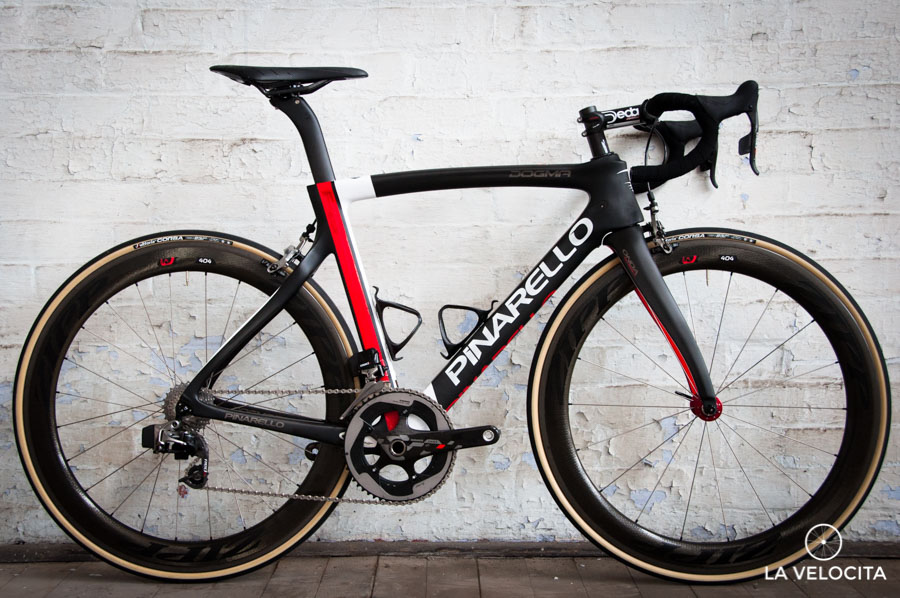HOW TO BRAG ABOUT YOUR...PINARELLO

We’re starting a new series based around the brag-worthy facts you might not know about famous cycling brands.
As everyone La Velocita’s secret volcano lair is currently tuning in to the Giro, we’re in an Italian mood. Here are 5 facts you might not have known about one of Italian cycling’s most famous bike brands: Pinarello.
Words - Tom McQuillan
Image - Mike Boudrie
Cycling is an expensive sport, and we all know there’s no point paying for that high-end bike or those whiz-bang carbon fibre wheels if you’re perceived as having ‘all the gear but no idea.’
With that in mind, it’s often a good idea to brush up on some of the more noteworthy facts about the bike you’ve just dropped a small fortune on, lest a casual question from an inquisitive riding partner expose you as someone with more money than sense.
FROM HUMBLE BEGINNINGS
While today the last rider in the peloton at a grand tour is awarded the honorary title of lanterne rouge at the Tour de France or maglia nera at the Giro, from 1946-1951 an actual black jersey was awarded to the last man in the standings at the Giro. Though his professional career was largely unremarkable, company founder Giovanni Pinarello is most famous for “winning” the last official maglia nera in 1951, finishing 3 hours, 26 minutes and 11 seconds behind the maglia rosa of Fiorenzo Magni.
The jersey was actually discontinued after 1951 because of the lengths that riders were going to in order to win, which included puncturing their own tyres and hiding in barns near finish towns or roadside bars in order to lose the maximum amount of time without being eliminated from the race! Pinarello wasn’t selected for the 1952 Giro, but his team gave him 100,000 lira (a fairly substantial amount in those days) as a way of apologising, which he used to help set up his own bike manufacturing business.
THE FIRST BIG WIN
The Pinarello brand gradually grew in influence throughout the ‘50s and ‘60s, before taking its first grand tour victory in 1975 when the Italian Fausto Bertoglio won the Giro d’Italia. Bertoglio, riding for the Jolly-Ceramica team, finally won the pink jersey after an engrossing battle with Francisco Galdós, a Spaniard riding for the KAS team. That race with a summit finish up a freezing Passo dello Stelvio, which Galdós won, but not by enough time to take the pink jersey off Bertoglio’s shoulders. To this day it’s the only example in history of one of cycling’s grand tours concluding with a summit finish, and a photo of Galdós and Bertoglio on the Stelvio later graced the cover of Herbie Sykes’ excellent book Maglia Rosa: Triumph and Tragedy at the Giro d’Italia.
DOMINATING THE TOUR
Pinarello has been one of the most successful bike manufacturers at the Tour de France, having taken 12 yellow jersey wins with 7 different riders in 28 years since Pedro Delgado took their first win while riding for the Reynolds team in 1988. Since that first victory, bikes carrying the Pinarello name (rumours persist that some of the Tour-winning frames may have been custom frames bearing Pinarello stickers) have been ridden to Tour victories by Miguel Indurain (Banesto), Bjarne Riis and Jan Ullrich (Telekom), Oscar Pereiro (Caisse d’Epargne), and Bradley Wiggins and Chris Froome (Team Sky), including in seven consecutive years from 1991-1997.
Eric Zabel (Telekom) also rode a Pinarello to six consecutive wins in the green jersey competition from 1996-2001, and Olympic gold medals in the road race at the 1984 and 2000 Olympics by were won by the Pinarello-mounted Alexi Grewal (USA) and Jan Ullrich (Germany) respectively.
FUNNY BIKES - AT THE FOREFRONT OF DESIGN
Pinarello have also been responsible for some of cycling’s zaniest bike designs, the most famous of which was the Espada time trial bike ridden in Miguel Indurain’s world hour record attempt in 1994. At the time it was the boldest bike design in the world, an example of what was possible thanks to the relatively new technology of carbon fibre.
A modified version was also used by Indurain during time trials in 1995, including his final victory at the Tour de France. Why it was called the Espada is a bit of a mystery to us though - espada is the Spanish word for sword, and we’ve never seen anything that looks less like a sword in our whole lives!
While later designs were more subdued, there were still some interesting features on later models, such as the undulating fork (Pinarello called it the ‘Onda’, after the Spanish word for wave) on the Dogma frame ridden by Mark Cavendish during his stint with team Sky in 2012, when he wore the rainbow jersey of world champion.
PINARELLO TODAY
Today Pinarello’s road cycling frames are sold almost entirely in carbon fibre, and sold at premium prices. We did a quick search across a few websites looking for a deal on a cheap Pinarello and found that new models bought from shops can range from around $2,500 AUD for a sportive-focused Razha model to some truly eye-watering, jaw-dropping, second-mortgage-requiring prices for new versions of their range-topping models like this stunning new F8 with a top end build from the guys at Essendon Cyclery. It's begging to be ridden but to have the pleasure we'd guess you'd need to be parting with the best part of $20k. gulp.
Image - Mike Boudrie
It’s not as though you can buy a second-hand Pinarello with much confidence either, as the online market has been flooded with counterfeit bikes (dubbed ‘Chinarellos’ due to their main country of origin) in recent years, which has meant the company has had to spend a lot of time closing online auctions of knockoff bikes.
That should be everything you need to know to prove that you know your stuff about Pinarello bikes. Let us know if there are any other brands you want to know how to brag about!











Getting out and going long, and riding an epic with mates is one of the most enjoyable and memorable parts of cycling. Yeah, good hit outs of a morning, or on the weekend can be great fun, but the big, hard, long days in the saddle, those are the ones we sit and dream about.